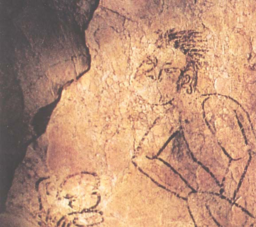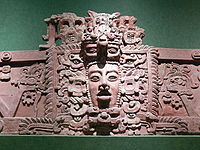- Naj Tunich
-
Naj Tunich Cave 
Part of a Naj Tunich wall drawing of a man in rare 3/4 profile performing ritual genital bloodletting.Location Poptún (Guatemala) Discovery 1979 Geology Karst Naj Tunich is a natural cave and an important archaeological site in Guatemala.
The discovery of the Naj Tunich caves, in Poptún southern Peten, Guatemala, in 1979 initiated the interest for Cave Archeology among Mayanists. Naj Tunich is the preeminent of Maya cave sites, boasting the most cave architecture ever found, the only elite masonry tombs reported from caves and the largest (and most exceptional) corpus of Maya cave inscriptions and paintings. The investigation of the site throughout the 1980s and the attempt to understand its obvious importance was the catalyst that led to the formation of the field of Maya cave archaeology. Naj Tunich has dozens of hieroglyphic texts and figures, as well as some handprints and about a half dozen incised petroglyphs.
This cave is so rich in artwork, artifacts, tombs, and monumental architecture that it effectively revolutionizes our picture of caves as an element of Maya social and religious life, particularly among the elite. The site possesses unique features, and gives evidence of child sacrifice, ritual bloodletting, and intercourse - sacred activities, which may have been accompanied by altered states of consciousness induced by alcoholic or hallucinogenic substances. Members of Maya royalty may be included among those who were buried there. A sacred site from as early as the late Preclassic period, around 100 BCE, this cave continued in use until the Late Classic era during 550–900, although its greatest use occurred during the Early Classic phase from 250–550.
Naj Tunich is the Maya term for cave and literally means "stone house", because caves were conceived of as places where the gods lived. But among caves, Naj Tunich must always have been something extraordinary. All the Kek’chi' Maya in the area agree that it is the largest cave and, shortly after its discovery, one man expressed the opinion that this was where the Maya maize god dwelt, or the entrance to Xibalbá. During the Late Pre-Classic and Classic Maya era, Naj Tunich was an important pilgrimage center on at least a regional scale. The site has always produced its share of surprises. Initially, the large corpus of inscriptions and paintings located deep within the tunnel system received the greatest attention. In carrying out the archaeological survey of the cave, Dr. Andrea Stone and Dr. James Brady, undertook the task of recording each and every image. In 1988, geologist George Veni found a previously unknown passage that dramatically increased the size of the cave and yielded a number of important new paintings. While recording the paintings, Drs Brady and Gene Ware in 1999 using a multispectral imaging system, discovered several totally unexpected cases of over-painting that are now cause to suppose that the history of the paintings is far more complex than previously thought.
Bibliography

Maya civilization People · Languages · Society Religion · Mythology · Sacrifice Cities · Architecture · Calendar Stelae · Textiles · Trade Pre-Columbian Music · Writing History Preclassic Maya Classic Maya collapse Spanish conquest of Yucatán Spanish conquest of Guatemala - Stone Andrea J. 1995-Images from the Underworld Naj Tunich and the Tradition of Maya Cave Painting ISBN 978-0-292-75552-9
- Brady, James E. 1989 An Investigation of Maya Ritual Cave Use with Special Reference to Naj Tunich, Peten, Guatemala. Ph.D. dissertation, University of California, Los Angeles.
- Brady, James E. y Sandra Villagrán de Brady, 1991 -La arqueología de la cueva Naj Tunich: Patrones de utilización ritual. En II Simposio de Investigaciones Arqueológicas en Guatemala, 1988 (editado por J.P. Laporte, S. Villagrán, H. Escobedo, D. de González y J. Valdés), pp. 179–186. Museo Nacional de Arqueología y Etnología, Guatemala. [1]
- Andrea Stone—Regional Variation in Maya Cave Art. Journal of Cave and Karst Studies 59(1): 33-42. [2]
- Science News 1998 Vol 154 No. 4 [3]
External links
Categories:- Maya sites
- Caves of Guatemala
- Limestone caves
- Wild caves
- Maya sites in Petén, Guatemala
- Cave sites in Mesoamerican archaeology
- Cultural Sites on the UNESCO World Heritage Tentative List
- Petén Department
- Rock art in North America
- Sacred caves
Wikimedia Foundation. 2010.

